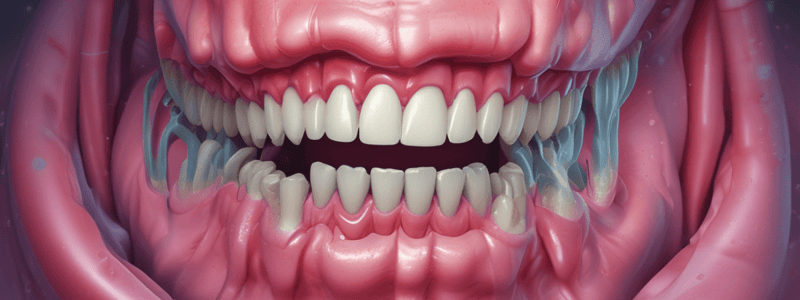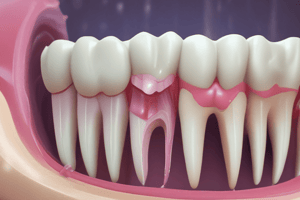Podcast
Questions and Answers
What type of irritants can cause inflammation of pulpal or periradicular tissues?
What type of irritants can cause inflammation of pulpal or periradicular tissues?
- Only living irritants
- Neither living nor nonliving irritants
- Only nonliving irritants
- Both living and nonliving irritants (correct)
What type of microorganisms are present in carious dentin and enamel?
What type of microorganisms are present in carious dentin and enamel?
- Klebsiella pneumoniae and Pseudomonas aeruginosa
- Actinomyces and Streptococcus pyogenes
- Streptococcus pneumoniae and Escherichia coli
- Streptococcus mutans and lactobacilli (correct)
What is the primary response of pulp tissue to the presence of microorganisms and their by-products in dentin?
What is the primary response of pulp tissue to the presence of microorganisms and their by-products in dentin?
- Infiltration by chronic inflammatory cells such as macrophages, lymphocytes, and plasma cells (correct)
- Infiltration by polymorph nuclear (PMN) leukocytes
- Infiltration by basophils and mast cells
- Infiltration by neutrophils and eosinophils
What happens to the pulp tissue when actual exposure occurs?
What happens to the pulp tissue when actual exposure occurs?
What colonize and persist at the site of necrosis after pulp exposure?
What colonize and persist at the site of necrosis after pulp exposure?
What can also irritate pulp or periradicular tissues?
What can also irritate pulp or periradicular tissues?
What is the result of chronic inflammation of the young pulp in carious crowns?
What is the result of chronic inflammation of the young pulp in carious crowns?
What is the recommended treatment for teeth with signs and symptoms of irreversible pulpitis?
What is the recommended treatment for teeth with signs and symptoms of irreversible pulpitis?
What is the characteristic discoloration of the crown in calcific metamorphosis?
What is the characteristic discoloration of the crown in calcific metamorphosis?
What is a common symptom of hyperplastic pulpitis?
What is a common symptom of hyperplastic pulpitis?
What is the usual response to pulpal and periapical tests in intracanal resorption?
What is the usual response to pulpal and periapical tests in intracanal resorption?
What can cause extensive calcification in the pulp?
What can cause extensive calcification in the pulp?
What is the recommended treatment for intracanal resorption?
What is the recommended treatment for intracanal resorption?
What is a possible nidus for pulp calcification?
What is a possible nidus for pulp calcification?
What is the result of progressive internal resorption involving the pulp chamber?
What is the result of progressive internal resorption involving the pulp chamber?
What can occur in response to irritation or death and replacement of odontoblasts?
What can occur in response to irritation or death and replacement of odontoblasts?
What is the characteristic of the pulp in intracanal resorption?
What is the characteristic of the pulp in intracanal resorption?
What is the consequence of progressive internal resorption involving the lateral periodontium?
What is the consequence of progressive internal resorption involving the lateral periodontium?
What is the clinical diagnostic category indicating death of the dental pulp?
What is the clinical diagnostic category indicating death of the dental pulp?
What type of symptoms are associated with acute apical periodontitis?
What type of symptoms are associated with acute apical periodontitis?
What is the characteristic of normal apical tissues?
What is the characteristic of normal apical tissues?
What is the characteristic of symptomatic apical periodontitis?
What is the characteristic of symptomatic apical periodontitis?
What is asymptomatic apical periodontitis?
What is asymptomatic apical periodontitis?
What is the result of pulp necrosis by itself?
What is the result of pulp necrosis by itself?
What characterizes a chronic apical abscess?
What characterizes a chronic apical abscess?
What is typical of an acute apical abscess?
What is typical of an acute apical abscess?
What radiographic signs are typically seen in a chronic apical abscess?
What radiographic signs are typically seen in a chronic apical abscess?
What is condensing osteitis?
What is condensing osteitis?
What symptoms are often experienced by patients with an acute apical abscess?
What symptoms are often experienced by patients with an acute apical abscess?
Flashcards are hidden until you start studying



